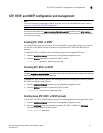
Dell Converged Enhanced Ethernet Administrator’s Guide 47
53-1002116-01
MSTP overview
6
10. Configure the bridge hello time value. For details, see “Specifying the bridge hello time (STP
and RSTP)” on page 54.
switch(conf-stp)#hello-time 5
11. Flush the MAC addresses from the VLAN FDB. For details, see “Flushing MAC addresses (RSTP
and MSTP)” on page 57.
switch(config)#spanning-tree tc-flush-standard
12. Enable PortFast on switch ports using the spanning-tree portfast command. For details, see
“Enabling port fast (STP)” on page 61. Note that this step is optional.
NOTE
PortFast only needs to be enabled on ports that connect to workstations or PCs. Repeat these
commands for every port connected to workstations or PCs. Do not enable PortFast on ports
that connect to other switches.
switch(config)#interface intengigabitethernet 0/10
switch(conf-if-te-0/10)#spanning-tree portfast
switch(conf-if-te-0/10)#exit
switch(config)#interface intengigabitethernet 0/11
switch(conf-if-te-0/11)#spanning-tree portfast
switch(conf-if-te-0/11)#exit
Repeat these commands for every port connected to workstations or PCs.
13. Set the following ports to forwarding mode:
• All ports of the root switch
• The root port
• The designated port
For details, see “Specifying the port priority” on page 61.
14. Enable the guard root feature with the spanning-tree guard root command. The guard root
feature provides a way to enforce the root bridge placement in the network. For detailed
information, refer to“Enabling the guard root” on page 59. Note that this step is optional.
All other switch ports connect to other switches and bridges are automatically placed in
blocking mode.
This does not apply to ports connected to workstations or PCs; these ports remain in the
forwarding state.
15. Enter the copy command to save the running-config file to the startup-config file.
switch(conf-if-te-0/1)#exit
switch(config)#end
switch#copy running-config startup-config
MSTP overview
The IEEE 802.1s Multiple STP (MSTP) helps create multiple loop-free active topologies on a single
physical topology. MSTP enables multiple VLANs to be mapped to the same spanning tree instance
(forwarding path), which reduces the number of spanning tree instances needed to support a large
number of VLANs. Each MSTP instance has a spanning tree topology independent of other


















